 |
|
Talk the Talk:
Dr. Repertoire defines some terms in everyday use among leading opera queens. |
ANECDOTE, DIVA: Perhaps because their lives onstage are so exciting ("weeping bitterly, she consents to the horrible bargain..."), divas have a way of romanticizing their offstage exploits as well. The result is a work of semi-fiction called The Diva Anecdote:
- Maria Callas is served with a subpoena; the next day she warns Walter Legge, "when I tell you the details, your blood will freeze!"
- At a Hollywood party Marilyn Horne shmoozes with a little fat drunk lady who turns out to be (no! yes!) Judy Garland!
- Zinka Milanov climbs into the wrong limousine after Birgit's first Met Aida and quips, "If Madame Nilsson takes my roles, I must take her Rolls!"
- Kathy Battle demands a makeup artist prior to a radio interview!
- Rise Stevens' right boob pops out during Carmen!
Now, let's face it, nobody's life is THAT exciting. So when you hear a diva anecdote, remember it has been edited for content and formatted to fit your screen. (see also X-RAY STORY.)
ASPIRATED COLORATURA: A method of separating the notes in fast music by interpolating lots of little "ha-ha"s . ("Sihihi, Lindohohohoro mihihio sahahaharaha.") Not the right way, but it's better than nothing. (see also YUGGAYUGGA.)
AUGENBLICKEN: see ZEDES, FAIRE LES
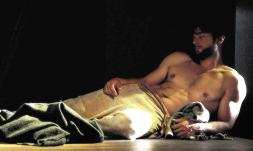 BARIHUNK: Emphasis on the "hunk." A singer of limited range-- usually F to F and not much more-- and even more limited repertoire. Schaunard, Papageno, Guglielmo, Figaro, Malatesta, Billy Budd, and well... that's about it. But boy, are they ever cute! Famous barihunks include Alan Titus, Hakan Hagegard, Dmitiri Hvorostovsky, Boje Skovus, Rodney Gilfrey, Nathan Gunn (pictured) and all those others whose headshots look so dreamy on a CD of Schubert lieder. Some synonyms for "Barihunk" include "Santa Fe Apprentice Artist," and "Bernstein protege" and "Opera News cover story." BARIHUNK: Emphasis on the "hunk." A singer of limited range-- usually F to F and not much more-- and even more limited repertoire. Schaunard, Papageno, Guglielmo, Figaro, Malatesta, Billy Budd, and well... that's about it. But boy, are they ever cute! Famous barihunks include Alan Titus, Hakan Hagegard, Dmitiri Hvorostovsky, Boje Skovus, Rodney Gilfrey, Nathan Gunn (pictured) and all those others whose headshots look so dreamy on a CD of Schubert lieder. Some synonyms for "Barihunk" include "Santa Fe Apprentice Artist," and "Bernstein protege" and "Opera News cover story."
 BARTOLITIS: A malady symptomized by an "artistic" choice to sing with a breathy tone and yuggayugga coloratura; other telltale signs include inaudibility, unsightly facial tics, a microscopic repertoire, an uncontrollable case of the cutes (see also DIVETTE), and a compulsion to rewrite her role in Nozze di Figaro. BARTOLITIS: A malady symptomized by an "artistic" choice to sing with a breathy tone and yuggayugga coloratura; other telltale signs include inaudibility, unsightly facial tics, a microscopic repertoire, an uncontrollable case of the cutes (see also DIVETTE), and a compulsion to rewrite her role in Nozze di Figaro.
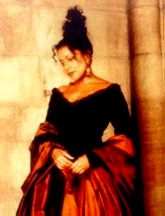 DIVETTE: Some divas are tall and some divas are not tall, but we're not talking about height here. A Divette is a sort of operatic Neely O'Hara: petite, cute, perky, but sometimes a just little, uh, "difficult". I can hear you saying, "He's talking about Kathleen Battle," and you're right, of course, but she's not the only one-- I say, you show me a woman who sings Zerbinetta, I'll show you a Divette. Harolyn Blackwell. Erie Mills. Ruth Welting. Roberta Peters. Sally Field. A Divette Story: Once there was a particularly haughty Divette who deigned to honor with her presence a gala fundraiser for a small New York opera company where she got her first break. Oh, she put on airs! Oh, she made demands! Oh, she patronized those of us who knew her before she obtained her current nose! Everyone associated with the event was ready to throttle her by curtain time. Signorina Thing closed her programme with "Glitter and Be Gay" ("you might almost call it my theme song"); as she launched into the piu allegro section her accompanist inadvertently (?) outpaced her for a moment. She tried to outrun him; he tried to keep up-- and the aria developed a fatal case of RUNAWAY TRAIN SYNDROME. Came time for the high Eb the Divette was completely out of breath. And backstage, mirth reigned unconfined. DIVETTE: Some divas are tall and some divas are not tall, but we're not talking about height here. A Divette is a sort of operatic Neely O'Hara: petite, cute, perky, but sometimes a just little, uh, "difficult". I can hear you saying, "He's talking about Kathleen Battle," and you're right, of course, but she's not the only one-- I say, you show me a woman who sings Zerbinetta, I'll show you a Divette. Harolyn Blackwell. Erie Mills. Ruth Welting. Roberta Peters. Sally Field. A Divette Story: Once there was a particularly haughty Divette who deigned to honor with her presence a gala fundraiser for a small New York opera company where she got her first break. Oh, she put on airs! Oh, she made demands! Oh, she patronized those of us who knew her before she obtained her current nose! Everyone associated with the event was ready to throttle her by curtain time. Signorina Thing closed her programme with "Glitter and Be Gay" ("you might almost call it my theme song"); as she launched into the piu allegro section her accompanist inadvertently (?) outpaced her for a moment. She tried to outrun him; he tried to keep up-- and the aria developed a fatal case of RUNAWAY TRAIN SYNDROME. Came time for the high Eb the Divette was completely out of breath. And backstage, mirth reigned unconfined.
FAKE PLACE: A vocal trick used to produce a "floated" high pianissimo (a la Price, Caballe, Te Kanawa, and all Viennese singers). It's crooning, not real singing, and it's not all that hard to do. Not at first. But it will get you in trouble: you'll lose the loud high notes (a la Price, Caballe, Te Kanawa and all Viennese singers.) If you MUST sing in the fake place (and I suppose you WILL, because those queens in the audience just OOZE when you do it), please try to keep the breath going and sing with an open throat. Otherwise the sound won't connect and you'll sound like Jessye Norman in the middle and Kathy Battle on top (sort of the way Jessye Norman sounds these days, come to think of it.) Hear the fake place.
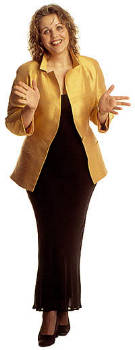 [NO] GAY FRIENDS: When a diva is wearing a unflattering dress, messy makeup or an ugly wig; or when she is doing stage business that just plain makes her look dumb (see photo, left), one says, "Obviously she has no Gay Friends,"
[NO] GAY FRIENDS: When a diva is wearing a unflattering dress, messy makeup or an ugly wig; or when she is doing stage business that just plain makes her look dumb (see photo, left), one says, "Obviously she has no Gay Friends," 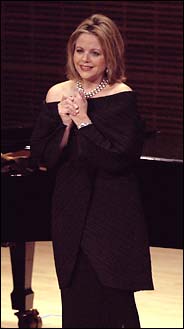 because, my dears, a gay friend would never have let her go on stage looking anything less than diva-esque (see photo, right). Hey, that's what fags are for. Oddly enough, even some singers who have multitudes of homosexual acquaintences have no Gay Friends. I mean, look at Ruth Ann Swenson. Now Carol Vaness, on the other hand, has the Gayest Friends in the world. The lack of Gay Friends has been known to turn an otherwise perfectly mediocre production into a TRAINWRECK. Dr. Repertoire recalls a gala he was assisting with a few years ago. Suddenly a voice boomed over his headphones: "Dr. Repertoire, please report to Miss C------'s dressing room immediately! "O dio," thought Dr. R, "Laryngitis? Argument with the maestro? Broken tooth cap?" Brimming with trepidation but determined to put on a brave front, Dr. R arrived at Madame's room to be confronted with the demand: "What do you think-- the multicolored shawl? Or the red with the fringe? And which brooch?" (PS: She went on looking Fabulous.) because, my dears, a gay friend would never have let her go on stage looking anything less than diva-esque (see photo, right). Hey, that's what fags are for. Oddly enough, even some singers who have multitudes of homosexual acquaintences have no Gay Friends. I mean, look at Ruth Ann Swenson. Now Carol Vaness, on the other hand, has the Gayest Friends in the world. The lack of Gay Friends has been known to turn an otherwise perfectly mediocre production into a TRAINWRECK. Dr. Repertoire recalls a gala he was assisting with a few years ago. Suddenly a voice boomed over his headphones: "Dr. Repertoire, please report to Miss C------'s dressing room immediately! "O dio," thought Dr. R, "Laryngitis? Argument with the maestro? Broken tooth cap?" Brimming with trepidation but determined to put on a brave front, Dr. R arrived at Madame's room to be confronted with the demand: "What do you think-- the multicolored shawl? Or the red with the fringe? And which brooch?" (PS: She went on looking Fabulous.)
GRAND OPERA BUZZ: That breathless, tingly, ecstatic feeling you get when you are at what Ethan Mordden calls a "demented" performance. It feels like really excellent speed but it's not nearly so hard on your liver. The Grand Opera Buzz can be caused by fabulous singing, balls-to-the-wall acting, dazzling star quality or, oh, just call it magic. Some nights Dr. Repertoire felt the Buzz: Catherine Malfitano's Salome or Emilia Marty, Gwyneth Jones's "Gotterdammerung", Scotto's "Suor Angelica" or Fedora, Corsaro's production of "Die Tote Stadt", Pavarotti, Freni and Kleiber's "Boheme", Rysanek and Hoffman in "Die Walkure". As you can see, the Grand Opera Buzz is a rare pleasure indeed; enjoy it when you get the chance, and pay the rent next month.
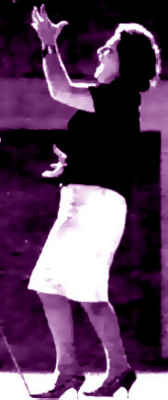 LADY FROM SVEDEN: A diva who is nobody's fool. So-called for a real Lady from Sveden, Birgit Nilsson, who (how shall I put this?) took shit from nobody. Surely you remember when La Nilsson protested that dark and darker Walkure production by showing up for the dress rehearsal wearing a winged miner's helmet? By extension, any no-bull diva is known as a Lady from Sveden. When some Assistant to an Assistant informed Marilyn Horne that the Met's new sets for "Carmen" would be built entirely of sound-absorbing carpet, the mezzo didn't scream. She didn't throw things. She just cooed "Ve ladies from Sveden don't like zis." And management trembled. When confronted with unreasonable demands from directors and conductors, another Lady From Sveden (Renata Tebaldi, to be specific) flashed her "dimples of iron" as she murmured "Please, is not for me, is for the public. They no want to see me like this." If a gold-lame costume doesn't flatter her coloring, a Lady from Sveden bellows "I'm not Sophie Tucker, goddammit" (Horne again, Met debut) or else she chops the offending garment in half (
Beverly Sills, La Scala debut). And when a creepazoid General Manager attempts to give the tenor the final curtain call after "Gioconda" (imagine!),a Lady from Sveden (Renata Scotto, San Francisco, and on live TV, yet!) shrieks, "Siete gente di merda!" [You are people of excrement!] LADY FROM SVEDEN: A diva who is nobody's fool. So-called for a real Lady from Sveden, Birgit Nilsson, who (how shall I put this?) took shit from nobody. Surely you remember when La Nilsson protested that dark and darker Walkure production by showing up for the dress rehearsal wearing a winged miner's helmet? By extension, any no-bull diva is known as a Lady from Sveden. When some Assistant to an Assistant informed Marilyn Horne that the Met's new sets for "Carmen" would be built entirely of sound-absorbing carpet, the mezzo didn't scream. She didn't throw things. She just cooed "Ve ladies from Sveden don't like zis." And management trembled. When confronted with unreasonable demands from directors and conductors, another Lady From Sveden (Renata Tebaldi, to be specific) flashed her "dimples of iron" as she murmured "Please, is not for me, is for the public. They no want to see me like this." If a gold-lame costume doesn't flatter her coloring, a Lady from Sveden bellows "I'm not Sophie Tucker, goddammit" (Horne again, Met debut) or else she chops the offending garment in half (
Beverly Sills, La Scala debut). And when a creepazoid General Manager attempts to give the tenor the final curtain call after "Gioconda" (imagine!),a Lady from Sveden (Renata Scotto, San Francisco, and on live TV, yet!) shrieks, "Siete gente di merda!" [You are people of excrement!]
So, to sum up, "I'm a Lady from Sveden" means approximately "Don't fuck with me, fellas-- this ain't my first time at the sitzprobe!"

 MOEDLROLLEN: a de facto fach consisting of short but flashy character parts for a diva whose voice may be wrecked but everything else is still working just fine, thank you very much. Named after mean, moody, magnificent
Martha Moedl, who blew her imperfect instrument out in the service of Kunst at Bayreuth in the '50s, then turned (brillliantly) to character roles-and continued to sing such parts as the Old Countess until only months before her death at 89! These "third-career" parts mostly consist, as Christa Ludwig once said, of "witches and old ladies who walk with two sticks": the operatic equivalent of (at best)
Simone Signoret in Madame Roza; or (at worst) Joan Crawford in Trog. Mme. Ludwig and her fellow classy broads Regine Crespin, Anja Silja, Evelyn Lear, Christa Ludwig Leonie Rysanek, Helga Dernesch, Astrid Varnay and Regina Resnik each added a decade or more to the career by easing into the "Turban and Monocle" repertoire. MOEDLROLLEN: a de facto fach consisting of short but flashy character parts for a diva whose voice may be wrecked but everything else is still working just fine, thank you very much. Named after mean, moody, magnificent
Martha Moedl, who blew her imperfect instrument out in the service of Kunst at Bayreuth in the '50s, then turned (brillliantly) to character roles-and continued to sing such parts as the Old Countess until only months before her death at 89! These "third-career" parts mostly consist, as Christa Ludwig once said, of "witches and old ladies who walk with two sticks": the operatic equivalent of (at best)
Simone Signoret in Madame Roza; or (at worst) Joan Crawford in Trog. Mme. Ludwig and her fellow classy broads Regine Crespin, Anja Silja, Evelyn Lear, Christa Ludwig Leonie Rysanek, Helga Dernesch, Astrid Varnay and Regina Resnik each added a decade or more to the career by easing into the "Turban and Monocle" repertoire.
Among artists who are still alive and spitting, Renata Scotto has just added Madame Flora to her repertoire, and we continue to hope for her eventual Old Countess. Indefatigable Dame Gwyneth Jones seems poised to ease into Moedlrollen, with engagements as Die Hexe and Begbick on her calendar; her contemporaries Hildegard Behrens and Jessye Norman could do worse than to follow the Jones example. Since German singers are encouraged to go on performing until they drop, the German repertory system is the source of most Moedlrollen. The Italian stagione system, on the other hand, offers relatively few third-career roles. Mythic Magda ("You'll Have to Beat Me to Death with a Stick") Olivero therefore remained a teenaged virgin until well past her 60th year-- in fact, even after she buried her second husband. Widely regarded as "The Energizer Rabbit of Sopranos", Olivero has left her footprints all over the autumnal role for Italian divas, Giordano's Fedora.* The core Moedlrollen (not all of them sung by Mme. Moedl herself!) are:
Herodias
Klytemnaestra
Die Frau in Erwartung
Elle in La Voix Humaine
Mme. de Croissy
The Countess in Pikovaya Dama
Leocadia Begbick
The Kostelnicka
Die Hexe
Madame Flora
Requiring rather more voice (but favorites of the aggressively faded diva) are: The Marschallin
Graefin Geschwitz
La Zia Principessa
Die Amme
Ortrud
Emilia Marty
Waltraute
Kundry
Marie in Wozzeck
Claire Zachanassian
* La Olivero did of course get to some Moedlrollen: Kostelnicka (appearing opposite La Bumbarina, which certainly must have been, uh, a challenge). She also did Elle and The Countess. Another Italian Moedl role is whatever-her -name-is who sings "Esser madre a un inferno" in L'arlesiana, which Mmes. Nicolai and Tassinari got to in their Moedljahren..
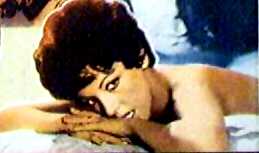 MOFFO THROAT: A form of mild laryngitis characterized by a husky, "sexy" vocal sound. Moffo Throat is caused by fatigue, mild infection, smoke, alcohol, and/or sucking cock. Proper treatment for Moffo Throat includes: MOFFO THROAT: A form of mild laryngitis characterized by a husky, "sexy" vocal sound. Moffo Throat is caused by fatigue, mild infection, smoke, alcohol, and/or sucking cock. Proper treatment for Moffo Throat includes:
- vocal rest
- steam
- antibiotics
- spending half a G on a laryngologist
- "Ladies and gentlemen, Miss Moffo is suffering from severe bronchitis, but, against her doctor's orders, she has consented to sing so as not to disappoint her many fans."
And if that doesn't work, you can try swooning during the introduction to "Caro nome"; it's effective if just a bit gaudy.
PHASER TRILL: Haven't you noticed how much Joan Sutherland's trill sounds like one of the phaser weapons from "Star Trek"?
RUNAWAY TRAIN SYNDROME: What happens when a section of operatic music just gets faster and faster and faster until there's no turning back. The most famous of all Runaway Trains is the "Si, vendetta" duet from "Rigoletto": the music is exciting to sing, which means the performers tend to speed up, meaning they don't have time to get a proper breath, meaning they speed up more, which makes the music even more exciting. . . And the next thing you know, Gilda and her dad are up there screaming their lungs out. Any cabaletta-like movement can develop into a Runaway Train, but that's not necessarily a bad thing-- from the audience's point of view, anyway. You see, when a Runaway Train manages to stay on the tracks, it's about as thrilling as anything that ever happens in an opera house. But when the Train derails, the result is, obviously, a TRAINWRECK. Is there a remedy for Runaway Train syndrome? Well, showing up for rehearsal sure doesn't hurt.
SCOTTO HEELS: [aka STRATAS SPIKES, COSSOTTO WEDGIES, or DOLORA ZAJICK COME FUCK ME PUMPS] Ultra high platform heels (very seventies) worn by ittybitty divas. The very first time I saw La Scotto live was in "Il tabarro" and she was leaping around that barge in seven-inch heels with three-inch platforms like a cross between a mountain goat and Bette Midler.  But even Miss M. might have flinched at the Bride of Frankenstein platform sandals La Scotto teetered atop later that evening as Suor Angelica. We must keep in mind that Scotto is barely five feet tall; she has to wear big heels to look plausible in just about any role except Gretel. As such, she is merely following in the, uh, footsteps of such diminuitive gay icons as Elizabeth Taylor, Mae West, Judy Garland and Madeline Kahn, high-heeled women all. Really, Scotto's quite graceful on those stilts: check out her classic Met telecasts of "Boheme" and "Manon Lescaut", which both, incidentally, include yummy closeups of Renata's massive footgear. What's even cooler is, the guys wear 'em too: think of Jose Carreras in his Conquistador Boots. And let us not forget Jon Vickers' cork-soled wedgies in his photo as Samson in the "Victor Book of the Opera"-- add cat-glasses and he's ready for a weekend at Palm Beach. For a current example of high-heeled diva excitement at its most unbalanced, check out, say, Aprile Millo and Dolora Zajick in the Met's Aida clomping around in platforms even Carmen Miranda might think twice about. But even Miss M. might have flinched at the Bride of Frankenstein platform sandals La Scotto teetered atop later that evening as Suor Angelica. We must keep in mind that Scotto is barely five feet tall; she has to wear big heels to look plausible in just about any role except Gretel. As such, she is merely following in the, uh, footsteps of such diminuitive gay icons as Elizabeth Taylor, Mae West, Judy Garland and Madeline Kahn, high-heeled women all. Really, Scotto's quite graceful on those stilts: check out her classic Met telecasts of "Boheme" and "Manon Lescaut", which both, incidentally, include yummy closeups of Renata's massive footgear. What's even cooler is, the guys wear 'em too: think of Jose Carreras in his Conquistador Boots. And let us not forget Jon Vickers' cork-soled wedgies in his photo as Samson in the "Victor Book of the Opera"-- add cat-glasses and he's ready for a weekend at Palm Beach. For a current example of high-heeled diva excitement at its most unbalanced, check out, say, Aprile Millo and Dolora Zajick in the Met's Aida clomping around in platforms even Carmen Miranda might think twice about.
 STEPFORD SOPRANO: A bionic diva. Lovely voice, strong technique, beautiful woman. And so dull you want to murder her. A Stepford Diva is at home in the recording studio, where the last vestiges of originality can be buffed off her performance. And the fans rave: "I just LOVE her "Tosca." It's so SOOTHING!" The Ur-Stepford Soprano was probably Nellie Melba; her glossy daughters include Kathleen Battle, Renee Fleming, June Anderson, Ruth Ann Swenson, and, of course, Kiri te Kanawa ("The World's Highest-Paid Church Soprano"). I say, give me imperfect anytime. (See also FAKE PLACE.) STEPFORD SOPRANO: A bionic diva. Lovely voice, strong technique, beautiful woman. And so dull you want to murder her. A Stepford Diva is at home in the recording studio, where the last vestiges of originality can be buffed off her performance. And the fans rave: "I just LOVE her "Tosca." It's so SOOTHING!" The Ur-Stepford Soprano was probably Nellie Melba; her glossy daughters include Kathleen Battle, Renee Fleming, June Anderson, Ruth Ann Swenson, and, of course, Kiri te Kanawa ("The World's Highest-Paid Church Soprano"). I say, give me imperfect anytime. (See also FAKE PLACE.)
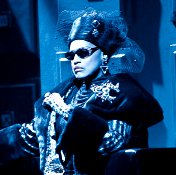 THAT WOMAN: a diva you don't like. No, a diva you can't stand. As in "Someone has to let THAT WOMAN know she has no business singing Norma!" Calling a singer "That Woman" is perhaps somewhat harsher than calling her "La" ("None of this nonsense of Carmen being casually discovered amidst the crowd for La Bumbry, oh no!") or "Madame" (Makropulos Case was in English because Madame Norman couldn't be BOTHERED to learn it in Czech.") But no matter how provoking the diva's behavior, one must draw the line at the nicknames some tacky queens thinks are so fucking witty, like "Miss Piggy" or "Jess Enormous" or "Monsterfat". Dr. Repertoire has it on very good authority that these are the very same tacky queens who tape photos of Calvin Klein
underwear models to their refrigerator doors, so I ask you. . . THAT WOMAN: a diva you don't like. No, a diva you can't stand. As in "Someone has to let THAT WOMAN know she has no business singing Norma!" Calling a singer "That Woman" is perhaps somewhat harsher than calling her "La" ("None of this nonsense of Carmen being casually discovered amidst the crowd for La Bumbry, oh no!") or "Madame" (Makropulos Case was in English because Madame Norman couldn't be BOTHERED to learn it in Czech.") But no matter how provoking the diva's behavior, one must draw the line at the nicknames some tacky queens thinks are so fucking witty, like "Miss Piggy" or "Jess Enormous" or "Monsterfat". Dr. Repertoire has it on very good authority that these are the very same tacky queens who tape photos of Calvin Klein
underwear models to their refrigerator doors, so I ask you. . .
THIS YEAR'S CALLAS: [aka "A Weltstar is Born"] Every year some dark-haired, dark-eyed girl with a piquant combination of voice, looks and stage presence is touted as the "next" Callas. You know the drill:
- Our embryonic diva appears out of nowhere singing a "Maria role" (Violetta, Lucia, Anna Bolena, whatever) in some European Podunk. Her acting, musicianship and vocal production all fit into the category of "interesting but uneven." The critics overlook her; the queens learn how to spell her name.
- She fills in (and triumphs) at a major summer festival. The critics notice her; the queens call her "flawless."
- She signs with a major record label and is mentioned in Opera News. The critics analyze her; the queens call her by her first name.
- She debuts at the Met and releases a crossover CD with an undignified cover photo. The critics rave; the queens, well, they hate to complain, but there are one or two LITTLE things...
- She's the subject of a "Times" Sunday piece in which she complains she does not want to be the "next Callas"; all she wants to be is the "first ME." The critics find fault; the queens write her off.
- She takes on a role that she has no business singing under a conductor who thinks he's Toscanini and a stage director who has a crush on the tenor and a costume designer who hates women and then two days before the opening she wakes up with a major case of MOFFO THROAT but she refuses to cancel; she and she alone gets blamed for the ensuing TRAINWRECK. The critics scream for blood; the queens say she wasn't that bad, just not that good.
- She gives a few more "interesting but uneven" performances to half-empty houses. She slinks back to Europe where she appears occasionally, always in weird, offbeat repertoire. The critics forget how to spell her name; the queens begin to collect her pirates.
When one realizes that Miss X is doing the Faux-Callas thing, the only proper response (besides deep and sincere pity) is to sing, sing, sing:
Have you met my good friend Maria,
The craziest girl in her Fach?
You'll know her the minute you see her:
She's the one who abuses her glottal attack!
| see also:
|
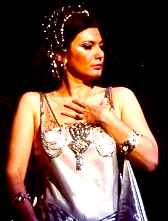 |
- SULIOTIS, ELENA
- SASS, SYLVIA
- NICOLESCU, MARIANA
- COTUBAS, ILEANA
- CHRISTOS, MARIANA
- GASDIA, CECELIA
- CUBERLI, LELLA
- FABBRICINI, TIZIANA
- GHEORGHIU, ANGELA
|
TRAINWRECK: A catastrophe. A solemn fiasco. A disaster on a truly Biblical scale. An operatic "Cable Guy". In other words, A Mess, and we're not talking Petite Mess Solonelle here, we're talking Mess in H-moll. Many operatic first nights were Trainwrecks: "Barbiere di Siviglia", "Madama Butterfly", the Paris version of "Tannhauser", to name a few. Some more recent Trainwrecks:
- The opening night of Robert Willson's Lohengrin at the Met, which incited a wall of boos so threatening that Wilson's and the theater's PR people are STILL trying to spin it as an "internet conspiracy."
- Te Kanawa's first New York Violetta when she forgot both the words and the music of Act IV
- Behrens' opening-night Elektra when she cracked the first "Agammemnon"
- The new Met production of Butterfly when Licia Albanese led the audience in booing Gian-Carlo del Monaco off the stage
- Franceca Zambello's Lucia, from which June Anderson really never has completely recovered
- Pavarotti's most recent attempt at Fille du Regiment, which required a full-scale press conference the following day for a (futile) attempt at damage control
- Any recent Cheryl Studer performance
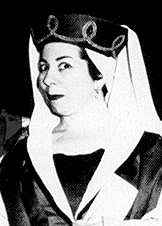 WACKY NEIGHBOR: Although it is true there are no operatic characters named "Ethel Mertz", "Millie Helper", "Howard Borden", "Phyllis Lindstrom" or "Cosmo Kramer" (more's the pity!), opera certainly does not lack for grateful parts for goofy sidekicks. Something about the limited time on stage and the opportunity to steal the show from hard-working stars always brings out the prosciutto in supporting artists: think of Marianne in Rosenkavalier, or the Sergeant in Barbiere, or the Duchess of Krakenthorp in Fille du Regiment or Hauk-Sendorf in Makropulos Case. None of these roles is more than a few lines long, but they can repay a hard-working Wacky Neighbor with both applause and the lion's share of the reviews. Look, I'll make it easy: any role Anthony Laciura sings is, by definition, a Wacky Neighbor. WACKY NEIGHBOR: Although it is true there are no operatic characters named "Ethel Mertz", "Millie Helper", "Howard Borden", "Phyllis Lindstrom" or "Cosmo Kramer" (more's the pity!), opera certainly does not lack for grateful parts for goofy sidekicks. Something about the limited time on stage and the opportunity to steal the show from hard-working stars always brings out the prosciutto in supporting artists: think of Marianne in Rosenkavalier, or the Sergeant in Barbiere, or the Duchess of Krakenthorp in Fille du Regiment or Hauk-Sendorf in Makropulos Case. None of these roles is more than a few lines long, but they can repay a hard-working Wacky Neighbor with both applause and the lion's share of the reviews. Look, I'll make it easy: any role Anthony Laciura sings is, by definition, a Wacky Neighbor.
X-RAY STORY: A type of DIVA ANECDOTE that's all windup and no delivery. Named for a story told by Renata Scotto for the Met's 100th Annviersary Gala. It seems Renata took a bad fall at the end of her debut Butterfly back in '65. She was in terrific pain, was rushed to the hospital... But let her tell it. "I tink I brek my nack. Waal, it toorn out I was all royt, but I 'ave to 'ave an x-rai." Pretty lame, huh? I mean, you expect a lot bigger payoff: amnesia, at least. Or else maybe she has to do rehab with a little old physical therapist who turns out to be, say, Toti dal Monte. Or else she's paralyzed and, oh, let's see... she says she never wants to sing again and she becomes a recluse and then she meets this cheerful little disabled boy with a really great singing voice and then bitter Renata agrees to attend the kid's performance of "Amahl and the Night Visitors" and, wait, it's Christmas Eve, and at the end of the show the kid really does walk and then Renata realizes the true meaning of Christmas and she sings "You'll Never Walk Alone" with a chorus of children from lots of nations. See, that would be a real Diva Anecdote. But instead, spoilsport Renata pops a Tylenol and gets on with her life. ("It hoort so mahch!") Divas beware: if you insist on telling X-ray Stories, Edward Downes will 86 you from the Singers Round Table.
YUGGAYUGGA COLORATURA: A method of articulating florid music with lots of ittybitty glottal attacks. It's superclean, but not very pretty: at its worst it sounds like simultaneous gargling and yodeling ("Si, Lindorulugalugalug miugalug sagalugarugalug") Mostly mezzos do the Yuggayugga thing, (e.g., Beganza, Horne, Bartoli), but the all-time Yugmistress is undoubtedly Cristina Deutetekom, whose Queen of the Night sounded like she had a throatful of marbles. Here's a sample of yuggayugga.
ZEDES, FAIRE LES: What the audience does during "Pelleas et Melisande." (During "Parsifal" the same process is called "VIERZIG AUGENBLICKEN ZU HABEN")
Dr. Repertoire (who knows everything about opera) is a regular contributor to parterre box, the queer opera zine.
|


 BARIHUNK: Emphasis on the "hunk." A singer of limited range-- usually F to F and not much more-- and even more limited repertoire. Schaunard, Papageno, Guglielmo, Figaro, Malatesta, Billy Budd, and well... that's about it. But boy, are they ever cute! Famous barihunks include Alan Titus, Hakan Hagegard, Dmitiri Hvorostovsky, Boje Skovus, Rodney Gilfrey, Nathan Gunn (pictured) and all those others whose headshots look so dreamy on a CD of Schubert lieder. Some synonyms for "Barihunk" include "Santa Fe Apprentice Artist," and "Bernstein protege" and "Opera News cover story."
BARIHUNK: Emphasis on the "hunk." A singer of limited range-- usually F to F and not much more-- and even more limited repertoire. Schaunard, Papageno, Guglielmo, Figaro, Malatesta, Billy Budd, and well... that's about it. But boy, are they ever cute! Famous barihunks include Alan Titus, Hakan Hagegard, Dmitiri Hvorostovsky, Boje Skovus, Rodney Gilfrey, Nathan Gunn (pictured) and all those others whose headshots look so dreamy on a CD of Schubert lieder. Some synonyms for "Barihunk" include "Santa Fe Apprentice Artist," and "Bernstein protege" and "Opera News cover story."  BARTOLITIS: A malady symptomized by an "artistic" choice to sing with a breathy tone and
BARTOLITIS: A malady symptomized by an "artistic" choice to sing with a breathy tone and 
 [NO] GAY FRIENDS: When a diva is wearing a unflattering dress, messy makeup or an ugly wig; or when she is doing stage business that just plain makes her look dumb (see photo, left), one says, "Obviously she has no Gay Friends,"
[NO] GAY FRIENDS: When a diva is wearing a unflattering dress, messy makeup or an ugly wig; or when she is doing stage business that just plain makes her look dumb (see photo, left), one says, "Obviously she has no Gay Friends,"  because, my dears, a gay friend would never have let her go on stage looking anything less than diva-esque (see photo, right). Hey, that's what fags are for. Oddly enough, even some singers who have multitudes of homosexual acquaintences have no Gay Friends. I mean, look at Ruth Ann Swenson. Now Carol Vaness, on the other hand, has the Gayest Friends in the world. The lack of Gay Friends has been known to turn an otherwise perfectly mediocre production into a
because, my dears, a gay friend would never have let her go on stage looking anything less than diva-esque (see photo, right). Hey, that's what fags are for. Oddly enough, even some singers who have multitudes of homosexual acquaintences have no Gay Friends. I mean, look at Ruth Ann Swenson. Now Carol Vaness, on the other hand, has the Gayest Friends in the world. The lack of Gay Friends has been known to turn an otherwise perfectly mediocre production into a  LADY FROM SVEDEN: A diva who is nobody's fool. So-called for a real Lady from Sveden,
LADY FROM SVEDEN: A diva who is nobody's fool. So-called for a real Lady from Sveden,  MOFFO THROAT: A form of mild laryngitis characterized by a husky, "sexy" vocal sound. Moffo Throat is caused by fatigue, mild infection, smoke, alcohol, and/or sucking cock. Proper treatment for Moffo Throat includes:
MOFFO THROAT: A form of mild laryngitis characterized by a husky, "sexy" vocal sound. Moffo Throat is caused by fatigue, mild infection, smoke, alcohol, and/or sucking cock. Proper treatment for Moffo Throat includes:
 But even Miss M. might have flinched at the Bride of Frankenstein platform sandals La Scotto teetered atop later that evening as Suor Angelica. We must keep in mind that Scotto is barely five feet tall; she has to wear big heels to look plausible in just about any role except Gretel. As such, she is merely following in the, uh, footsteps of such diminuitive gay icons as Elizabeth Taylor, Mae West, Judy Garland and Madeline Kahn, high-heeled women all. Really, Scotto's quite graceful on those stilts: check out her classic Met telecasts of "Boheme" and "Manon Lescaut", which both, incidentally, include yummy closeups of Renata's massive footgear. What's even cooler is, the guys wear 'em too: think of Jose Carreras in his Conquistador Boots. And let us not forget Jon Vickers' cork-soled wedgies in his photo as Samson in the "Victor Book of the Opera"-- add cat-glasses and he's ready for a weekend at Palm Beach. For a current example of high-heeled diva excitement at its most unbalanced, check out, say, Aprile Millo and Dolora Zajick in the Met's Aida clomping around in platforms even Carmen Miranda might think twice about.
But even Miss M. might have flinched at the Bride of Frankenstein platform sandals La Scotto teetered atop later that evening as Suor Angelica. We must keep in mind that Scotto is barely five feet tall; she has to wear big heels to look plausible in just about any role except Gretel. As such, she is merely following in the, uh, footsteps of such diminuitive gay icons as Elizabeth Taylor, Mae West, Judy Garland and Madeline Kahn, high-heeled women all. Really, Scotto's quite graceful on those stilts: check out her classic Met telecasts of "Boheme" and "Manon Lescaut", which both, incidentally, include yummy closeups of Renata's massive footgear. What's even cooler is, the guys wear 'em too: think of Jose Carreras in his Conquistador Boots. And let us not forget Jon Vickers' cork-soled wedgies in his photo as Samson in the "Victor Book of the Opera"-- add cat-glasses and he's ready for a weekend at Palm Beach. For a current example of high-heeled diva excitement at its most unbalanced, check out, say, Aprile Millo and Dolora Zajick in the Met's Aida clomping around in platforms even Carmen Miranda might think twice about.  STEPFORD SOPRANO: A bionic diva. Lovely voice, strong technique, beautiful woman. And so dull you want to murder her. A Stepford Diva is at home in the recording studio, where the last vestiges of originality can be buffed off her performance. And the fans rave: "I just LOVE her "Tosca." It's so SOOTHING!" The Ur-Stepford Soprano was probably Nellie Melba; her glossy daughters include Kathleen Battle, Renee Fleming, June Anderson, Ruth Ann Swenson, and, of course, Kiri te Kanawa ("The World's Highest-Paid Church Soprano"). I say, give me imperfect anytime. (See also
STEPFORD SOPRANO: A bionic diva. Lovely voice, strong technique, beautiful woman. And so dull you want to murder her. A Stepford Diva is at home in the recording studio, where the last vestiges of originality can be buffed off her performance. And the fans rave: "I just LOVE her "Tosca." It's so SOOTHING!" The Ur-Stepford Soprano was probably Nellie Melba; her glossy daughters include Kathleen Battle, Renee Fleming, June Anderson, Ruth Ann Swenson, and, of course, Kiri te Kanawa ("The World's Highest-Paid Church Soprano"). I say, give me imperfect anytime. (See also  THAT WOMAN: a diva you don't like. No, a diva you can't stand. As in "Someone has to let THAT WOMAN know she has no business singing Norma!" Calling a singer "That Woman" is perhaps somewhat harsher than calling her "La" ("None of this nonsense of Carmen being casually discovered amidst the crowd for La Bumbry, oh no!") or "Madame" (
THAT WOMAN: a diva you don't like. No, a diva you can't stand. As in "Someone has to let THAT WOMAN know she has no business singing Norma!" Calling a singer "That Woman" is perhaps somewhat harsher than calling her "La" ("None of this nonsense of Carmen being casually discovered amidst the crowd for La Bumbry, oh no!") or "Madame" (
 WACKY NEIGHBOR: Although it is true there are no operatic characters named "Ethel Mertz", "Millie Helper", "Howard Borden", "Phyllis Lindstrom" or "Cosmo Kramer" (more's the pity!), opera certainly does not lack for grateful parts for goofy sidekicks. Something about the limited time on stage and the opportunity to steal the show from hard-working stars always brings out the prosciutto in supporting artists: think of Marianne in Rosenkavalier, or the Sergeant in Barbiere, or the Duchess of Krakenthorp in Fille du Regiment or Hauk-Sendorf in Makropulos Case. None of these roles is more than a few lines long, but they can repay a hard-working Wacky Neighbor with both applause and the lion's share of the reviews. Look, I'll make it easy: any role Anthony Laciura sings is, by definition, a Wacky Neighbor.
WACKY NEIGHBOR: Although it is true there are no operatic characters named "Ethel Mertz", "Millie Helper", "Howard Borden", "Phyllis Lindstrom" or "Cosmo Kramer" (more's the pity!), opera certainly does not lack for grateful parts for goofy sidekicks. Something about the limited time on stage and the opportunity to steal the show from hard-working stars always brings out the prosciutto in supporting artists: think of Marianne in Rosenkavalier, or the Sergeant in Barbiere, or the Duchess of Krakenthorp in Fille du Regiment or Hauk-Sendorf in Makropulos Case. None of these roles is more than a few lines long, but they can repay a hard-working Wacky Neighbor with both applause and the lion's share of the reviews. Look, I'll make it easy: any role Anthony Laciura sings is, by definition, a Wacky Neighbor.